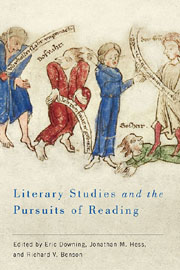Book contents
- Frontmatter
- Contents
- List of Illustrations
- Introduction
- Part I Medieval and Early Modern Practices of Reading
- Part II Reading, Secularization, and Transcendence in the Long Nineteenth Century
- 5 Reading and the Writing of German-Jewish History
- 6 Similia Similibus Curentur: Homeopathy and Its Magic Wand of Analogy
- 7 Reading and Rhetorical Generation: The Example of Blake's Thel
- 8 Sender Glatteis Reads Lessing and Comes to a Sad End: Some Thoughts on Karl Emil Franzos's Der Pojaz and the Problem of Jewish Reading
- Part III Theories and Practices of Reading in the Twentieth Century and Beyond
- Part IV Postscript: The Ends of Reading
- Works Cited
- Notes on the Contributors
- Index
6 - Similia Similibus Curentur: Homeopathy and Its Magic Wand of Analogy
from Part II - Reading, Secularization, and Transcendence in the Long Nineteenth Century
Published online by Cambridge University Press: 05 February 2013
- Frontmatter
- Contents
- List of Illustrations
- Introduction
- Part I Medieval and Early Modern Practices of Reading
- Part II Reading, Secularization, and Transcendence in the Long Nineteenth Century
- 5 Reading and the Writing of German-Jewish History
- 6 Similia Similibus Curentur: Homeopathy and Its Magic Wand of Analogy
- 7 Reading and Rhetorical Generation: The Example of Blake's Thel
- 8 Sender Glatteis Reads Lessing and Comes to a Sad End: Some Thoughts on Karl Emil Franzos's Der Pojaz and the Problem of Jewish Reading
- Part III Theories and Practices of Reading in the Twentieth Century and Beyond
- Part IV Postscript: The Ends of Reading
- Works Cited
- Notes on the Contributors
- Index
Summary
By all accounts, Samuel Hahnemann (1755–1843) merits a prominent place in the history of medicine as the only practicing physician ever to have founded an entire system of medical treatment, that of homeopathy. His insights and innovations were manifold. Even had he not invented the homeopathic cure, he was for his era a radical, farsighted thinker: he pioneered public hygiene, promoted a pure diet and healthy lifestyle, trenchantly criticized the harsh medical treatments common to his day, and read illness as a disruption of the mind-body connection and life's vital force. But although Hahnemann established a new medical paradigm, his innovation cannot be contemplated outside related systems of thought current at the time. Proponents of homeopathy, however, tend to present Hahnemann as unique and revolutionary, and they are not alone. Historians of medicine invariably allot him a chapter unto himself, constructing the two-centuries-long narrative of homeopathy with Hahnemann at its start. Unfortunately, the unintended result of this narrative drive to establish clear beginnings is that similarities between Hahnemann and German Romanticism are generally overlooked, in particular Romantic modes of reading. No doubt the chroniclers of homeopathy have been misled by the founder himself: although a learned, skilled translator fluent in seven languages, Hahnemann tended to promote himself as an innovator and denied being influenced by any medical predecessors. He publicly criticized, for instance, the Naturphilosophie of Schelling and his followers, writing that “their dualism, their polarization, and representation … their potentizing and depotentizing … incorporeal and ethereal,… soars aloft beyond our solar system, beyond the bounds of the actual.”
- Type
- Chapter
- Information
- Literary Studies and the Pursuits of Reading , pp. 130 - 147Publisher: Boydell & BrewerPrint publication year: 2012

